Assume that $f(x,y,z)$ is a function defined over the unit 2-sphere in three dimensions. Our aim is to explore the building blocks of $f$ using the partition command. Let's start with a spherefun object:
f = spherefun(@(x,y,z) 0.5 + sinh(5*x.*y.*z).*cos(x-y+2*z)) plot(f), axis off, hold on contour(f, 'color','k'),
f =
spherefun object
domain rank vertical scale
unit sphere 21 1.6
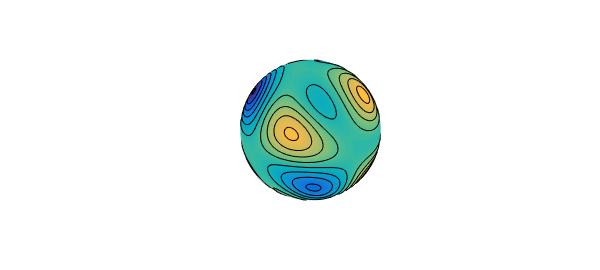
A spherefun can be seen as a sum of two spherefuns, one of them even/$\pi$-periodic and the other odd/$\pi$-anti-periodic [1]. Recall that a univariate function $g$ is $\pi$-anti-periodic if $g(x+\pi) = -g(x)$. The command `[fep, foa] = partition(f)' partitions $f$ accordingly.
[fep, foa] = partition(f)
err = norm(fep+foa - f)
subplot(1,2,1), plot(fep), hold on, contour(fep,'k')
title('even/periodic part'), axis off
subplot(1,2,2), plot(foa), hold on, contour(foa,'k')
title('odd/anti-periodic part'), axis off, axis off, hold off
fep =
spherefun object
domain rank vertical scale
unit sphere 11 1.2
foa =
spherefun object
domain rank vertical scale
unit sphere 10 0.94
err =
0
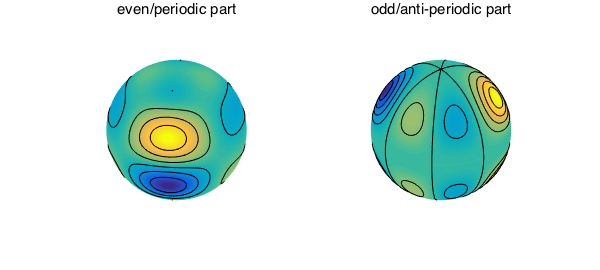
fep has a CDR decomposition [1] whose columns are even and whose rows are $\pi$-periodic (not just $2\pi$!):
[Ce, D, Rp] = cdr(fep);
clf, plot(Ce)
grid on, title('Columns of the even part of f')
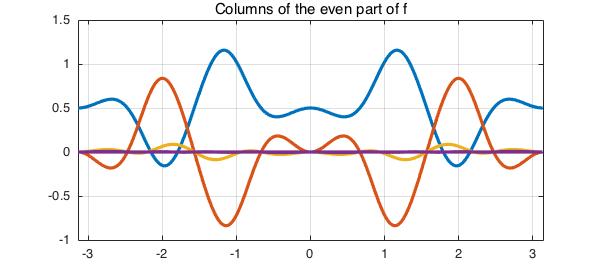
clf, plot(Rp)
grid on, title('Rows of the \pi-periodic part of f')
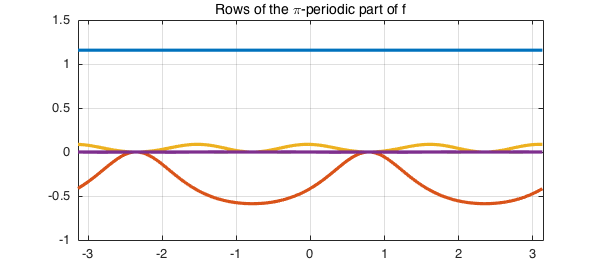
The other part of $f$, foa, has a CDR decomposition whose columns are odd and whose rows are $\pi$-anti-periodic:
[Co, D, Ra] = cdr(foa);
plot(Co),
grid on, title('Columns of the odd part of f')
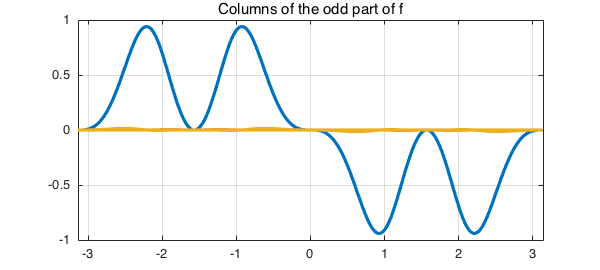
clf, plot(Ra)
grid on, title('Rows of the \pi-anti-periodic part of f')
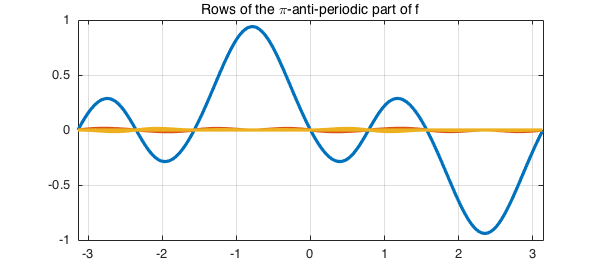
The integral of a spherefun is equal to the integral of its even/$\pi$-periodic piece, since the integral of any odd/$\pi$-anti-periodic spherefun is zero:
format long sum_f = sum2(f) sum_foa = sum2(foa) sum_fep = sum2(fep)
sum_f =
6.283185307179586
sum_foa =
0
sum_fep =
6.283185307179586
An equivalent partitioning is available for diskfuns [2].
References
-
A. Townsend, H. Wilber, and G. Wright, Computing with functions in spherical and polar geometries I. The sphere. SIAM J. Sci. Comput., 38 (2016) C403-C425.
-
A. Townsend, H. Wilber, and G. Wright, Computing with functions in spherical and polar geometries II. The disk, Submitted (2016).

